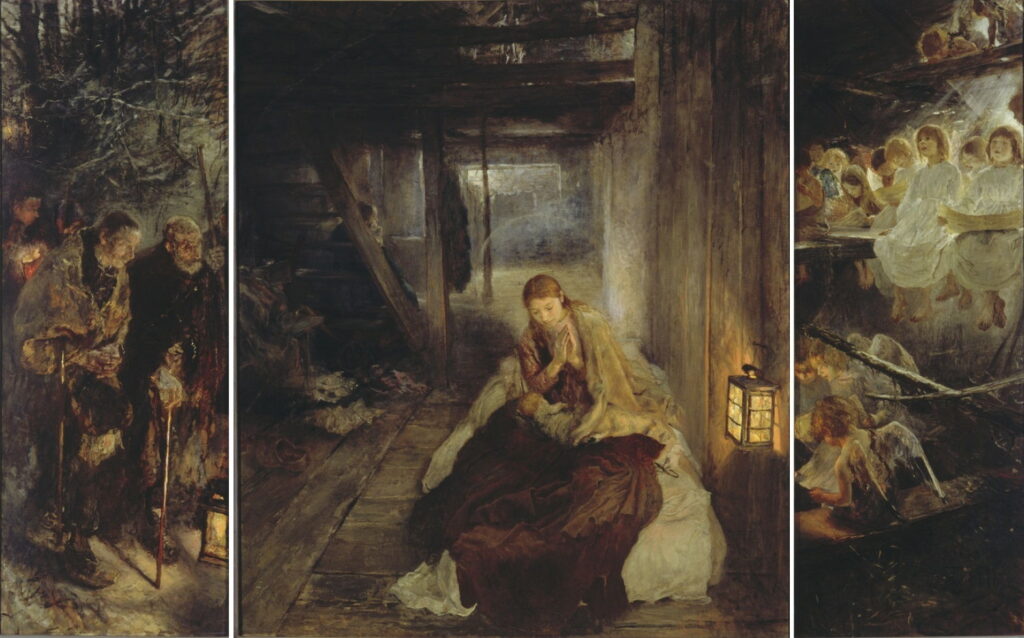Reading Visual Art: 203 Triptychs A

One of the common presentations for European paintings has been in the form of a folding, self-supporting group of several panels. As altarpieces these have graced the space above and behind the altar in a great many of the churches across the continent. While they can have anything from two to twenty or more panels, triptychs with three have been particularly popular, and have become widely adopted for secular paintings as well.
Polyptychs are often used to solve the problem of telling narratives in visual art. By providing two or more images they spare the artist the task of composing a single image that refers to two or more moments in time, for example using multiplex narrative. However, the viewer then needs to know in which order to read the panels, and to see how they integrate into a whole. In this and tomorrow’s article I show some examples of solutions.
Masaccio (1401–1428), Triptych of San Giovenale (1422), egg tempera on wood, 108 x 65 cm, 88 x 44 cm, Cascia di Reggello, Reggello, Italy. Photo by Sailko, via Wikimedia Commons.
Masaccio’s Triptych of San Giovenale was painted early in his career, in 1422, and was only discovered in 1961. It adopts a popular if not conventional layout for an altarpiece, with its central panel showing the Virgin Mary and infant Christ, with two winged angels in attendance. The left wing shows Saints Bartholomew and Blaise, and the right Saints Juvenal, patron of the commissioning church, and Anthony Abbot. Figures in the wings are looking at the central panel, although Saint Blaise is glancing furtively towards the viewer.
Robert Campin (1375/1379–1444), workshop of, Triptych with the Entombment of Christ (c 1410-1420), oil on panel, centre panel 60 x 48.9 cm, wings 60 x 22.5 cm, Courtauld Institute Gallery, London. Wikimedia Commons.
Robert Campin’s workshop painted this early narrative triptych of The Entombment of Christ in about 1410-1420. The thread runs from the Crucifixion at the left, where Christ’s cross is empty, through the central entombment scene, to the Resurrection with the empty tomb in the right wing. The figure kneeling at the foot of the left wing is the donor.
Hieronymus Bosch was a prolific painter of triptychs, and several of his finest have survived in excellent condition, considering that they’re more than five centuries old. They follow different compositional strategies.
Hieronymus Bosch (c 1450–1516), The Adoration of the Magi (Interior) (Saint Peter with donor, The Adoration of the Magi, Saint Agnes with donor) (1490-1500) (CR no. 9), oil on oak panel, 138 cm x 138 cm overall when open, Museo Nacional del Prado, Madrid. Wikimedia Commons.
The three panels of Bosch’s Adoration of the Magi from 1490-1500 form a continuous view of the local Brabant countryside, with its low rolling hills, and a city in the distance; this may be based on Antwerp, the donor’s city, or possibly ‘s-Hertogenbosch where the artist lived and worked. The Adoration itself is in the centre panel, while the wings show the donor and his family with countryside behind.
Hieronymus Bosch (c 1450–1516), The Garden of Earthly Delights (c 1495-1505), triptych, oil on oak panel, 220 x 390 cm, Museo Nacional del Prado, Madrid. Wikimedia Commons.
His famous Garden of Earthly Delights from about 1495-1505 follows a pattern distinctive to Bosch, with the left wing showing a scene from the garden of Eden before the fall of man, the centre containing the main theme, and the right wing the chaos and suffering of the apocalypse. This past-present-future layout is repeated in several of his other triptychs, and was adopted by others.
Hieronymus Bosch (c 1450–1516), The Haywain Triptych (c 1510-16), oil on oak panel, left wing 136.1 x 47.7 cm, central panel 133 × 100 cm, right wing 136.1 × 47.6 cm, Museo Nacional del Prado, Madrid. Wikimedia Commons.
This is perhaps best developed in his late Haywain Triptych from about 1510-16. The left wing here has a multiplex account of the Fall of Man set in the Garden of Eden, with God the Father shown in the narrative content and in Heaven above, and the fall of angels occurring at the same time. The central panel shows a rich cavalcade of figures, including the emperor and Pope, nobility, courtiers, and many peasants, accompanying a huge and heavily-laden wagon of hay, which is processing from left to right. They are being overseen from Heaven by Jesus Christ. Finally, the right panel shows sinners entering into Hell and undergoing physical torments, with its fires destroying all in the distance.
Although religious polyptychs continued through the Renaissance into the nineteenth century, secular triptychs didn’t become popular until the middle of the nineteenth century, when they were adopted by the Pre-Raphaelites and spread to continental Europe.
Dante Gabriel Rossetti (1828–1882), Paolo and Francesca da Rimini (1855), watercolour on paper, 25.4 x 44.9 cm, The Tate Gallery (Purchased with assistance from Sir Arthur Du Cros Bt and Sir Otto Beit KCMG through the Art Fund 1916), London. © The Tate Gallery and Photographic Rights © Tate (2019), CC-BY-NC-ND 3.0 (Unported), https://www.tate.org.uk/art/artworks/rossetti-paolo-and-francesca-da-rimini-n03056
Dante Gabriel Rossetti painted the story of Paolo and Francesca da Rimini in this watercolour triptych in 1855. At the left the lovers are reading the legend of Lancelot and Guinevere; in the centre are Dante and Virgil, and at the right Paolo and Francesca are being blown in the storms of the Second Circle of Hell in Dante’s Inferno.
Arthur Hughes (1832–1915), The Eve of St Agnes (1856), oil on canvas, 71 x 124.5 cm, The Tate Gallery, London (Bequeathed by Mrs Emily Toms in memory of her father, Joseph Kershaw 1931). Photographic Rights © Tate 2016, CC-BY-NC-ND 3.0 (Unported), http://www.tate.org.uk/art/artworks/hughes-the-eve-of-st-agnes-n04604
The following year Arthur Hughes told the story of The Eve of St Agnes in this triptych, also read from left to right. At the left Porphyro is approaching the castle. In the centre he has woken Madeline, who hasn’t yet taken him into her bed. At the right the couple make their escape over drunken revellers. There is also a second, undated version in the Ashmolean, Oxford, in which the left wing shows a slightly later moment, where Porphyro meets Angela at the entrance to the castle.
Hughes breaks from the tradition of the three panels being hinged, which allowed the wings to be closed over and protect the centre panel, and sets them into a single gilt whole, containing a lengthy quotation from the literary source.
Léon Frédéric (1856–1940), The Legend of Saint Francis (1882), media and dimensions not known, Palais des beaux-arts de Lille, Lille, France. Wikimedia Commons.
Léon Frédéric’s triptych showing The Legend of Saint Francis (1882) frames the panels individually, but is set in a single outer frame. These show separate episodes from this popular legend, ending at the right with the story of the wolf of Gubbio/Agubbio.
Fritz von Uhde (1848–1911), The Sacred Night (Triptych) (1888-89), oil on canvas, 134.5 x 117 cm, Staatliche Kunstsammlungen Dresden, Dresden, Germany. Wikimedia Commons.
Fritz von Uhde’s setting of the Nativity, The Sacred Night from 1888-89, centres on a modern interpretation of the classic Virgin and Child, with the adoration of the magi on the left, and an angelic choir singing amid the rafters of the barn on the right.




